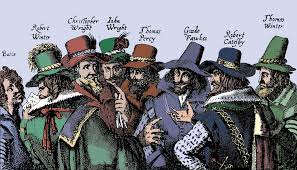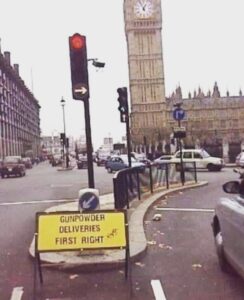The Forgotten Wives of the Gunpowder Plot
When History Becomes Personal
Remember, remember the Fifth of November,
Gunpowder, treason and plot…
Every Bonfire Night, fireworks burst across the sky, retelling the story of Guy Fawkes and the men who tried to blow up Parliament. Yet behind the smoke and sparks are other figures – women whose names have been lost to the centuries.
They were the wives, sisters and daughters of the plotters: women who sewed and prayed by candlelight, who waited through the nights of early November listening for hoofbeats, for news, for the knock that might end their world. I spent months researching them to use them in my book The Secrets of Crestwell Hall and found a few surprises along the way.
I’d like to introduce you to the forgotten women of the Gunpowder Plot.
The Known Wives
In every household touched by the Gunpowder Plot, there was a woman whose life would be changed forever.
Catherine Leigh, wife of Robert Catesby, was only twenty-one when she married the man who would ignite England’s most infamous conspiracy. A Protestant bride for a Catholic husband, she died young, leaving Catesby widowed and disillusioned. Was her death the catalyst for his deadly plan?
Martha Wright Percy grew up among rebels. Her brothers John and Christopher Wright were at the heart of the plot, and her husband, Thomas Percy, hired the cellar below the House of Lords from Mrs Susan Whynniard where the thirty-six barrels of gunpowder were stored. When the plot collapsed, Martha was arrested and questioned, yet somehow she walked free.
Gertrude Talbot, wife of Robert Wintour, belonged to a family whose bloodlines reached the throne itself. When her husband fled, wounded and desperate, she turned their home, Huddington Hall, into a refuge for the fleeing plotters. Her status saved her; her husband was hanged.
Dorothy Wintour, sister to Thomas and Robert, and wife to John Grant. She lived at Norbrook, where extra gunpowder and weapons were hidden. When the men escaped London, they stopped at her house to gather fresh supplies. After John Grant’s execution, Dorothy was taken to London, her home confiscated, her fortune gone.
Elizabeth Tyrwhitt, wife of Ambrose Rookwood, came from a dynasty of proud recusants. Her husband supplied the finest horses to the conspirators; she paid the price with arrest and humiliation.
Anne Tufton Tresham watched her husband, Francis, die in the Tower of London, his name forever linked to the Monteagle letter that betrayed them all.
And Mary Mulsho Digby, wife of Sir Everard Digby, was left to pick up the pieces after his execution. She raised their sons alone; one, Sir Kenelm Digby, would go on to become one of England’s great philosophers.
The Shadowed Wives
The lack of records made some of the women harder to find, they exist as whispers in margins, footnotes and the stories of others, but their voices deserve to be heard.
Dorothy Scott, wife of John Wright, fades almost entirely from record – perhaps a mother, perhaps not.
Margaret Ward Wright was married to Christopher (Kit) Wright. She may have borne six children before her husband was killed. She too was arrested, then released into silence.
Christina Browne Keyes, governess and widow, possibly linked to the recusant Browne family. She was married to the conspirator Robert Keyes. After his death, she was interrogated and freed.
Martha Bates, wife of Catesby’s loyal servant Thomas, may have helped to shelter priests at Coughton Court while her husband met his end. Her name flickers through the archives like candlelight – there, and then gone, leaving no trace of her maiden name.
The Unrecorded Wives
Two of the plotters appeared to be unmarried:
Maria Pulleine, sometimes called Mary Pulleyne, is said to have married Guy Fawkes and borne him a son, Thomas. No marriage records survive, but there are papers linking their families in Yorkshire. Was her name deliberately wiped from history?
Thomas Wintour left no record of a wife—though the imagination of storytellers has long supplied one.
Each of these women lived close enough to treason to feel its breath. Even if they never saw the gunpowder, they knew of the danger surroundeding their families.
The Women Who Survived
For those who lived through it, survival was a complicated mercy. Homes were seized, fortunes destroyed. Children were left fatherless. The women endured in quiet rooms, lighting candles for souls and men who had been branded traitors.
Their courage was not recorded in proclamations or trials but in endurance as they kept families together and held their faith when the world had turned against them.
When History Turned Personal
As I traced these women’s names through parish rolls, letters, and family trees, a pattern began to emerge: a hidden network of wives and cousins, linked by marriage and faith.
Then, one afternoon, I recognised a name: Tyrwhitt.
I had already seen it before on my own family tree. Through my mother’s line, I am directly related to Elizabeth Tyrwhitt, wife of Ambrose Rookwood. Through my father’s, to Mary Throckmorton, sister of Anne Throckmorton, mother of Robert Catesby himself.
Those links spiral outward—to Francis Tresham, to the Wintours, to Bess Throckmorton, wife of Sir Walter Raleigh, whose story inspired The Secrets of Crestwell Hall.
Suddenly, the past no longer felt distant. It was woven through my own bloodline. The women I had been searching for had been waiting all along.
✨ Remember the Women of November
This Bonfire Night, as the air fills with smoke and firelight, I’ll think not of the men with their barrels of powder but of the women who waited for them. The wives who prayed, the daughters who wept, the mothers who kept their names alive in whispers.
They are the forgotten wives of the Gunpowder Plot.
And, as it turns out, they are part of my story too.



